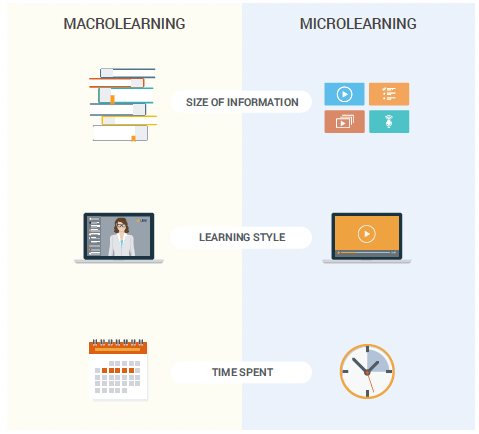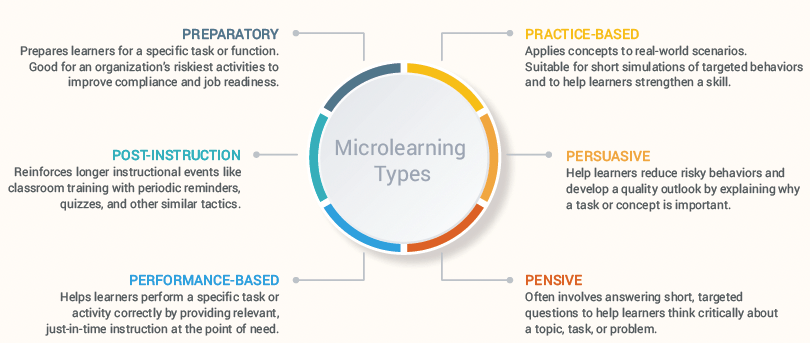Microlearning—the training approach based on short, focused learning experiences—
is not a new concept, but its use in compliance or GxP training is often overlooked.

Traditionally, GxP training uses a document-centric or macrolearning approach covering multiple learning objectives over several hours or days. Learners are asked to read long, dense written procedures that are sometimes irrelevant to their day-to-day work, affecting their productivity.
Proven to be a valuable complement to traditional document-centric training methods, microlearning can reduce the time burden on employees resulting in better learning outcomes and more fun.
A US-based emerging biotech firm supplemented their existing training with hyper-focused, multi-modal learning experiences to help their employees engage quickly, easily, and at the point of need. A new mobile app enabled their global workforce to access primary and follow-up trainings on their personal devices. The Standard Operating Procedure (SOP) chatbot feature allowed learners to connect and learn from with each other. In the first six months, 200-plus employees interacted with the app more than 5,000 times, prompting the company to broaden the initiative.
Within six months of applying these microlearning techniques, the company dramatically improved learners’ engagement and competency.
This guide provides proven, easy-to-implement microlearning strategies that will help you reinforce the right behaviors; improve adherence to SOPs;
and make GxP training engaging and effective in your organization.
How Microlearning Increases Learner Engagement
Microlearning improves learner interaction and knowledge retention with shorter, focused, more compelling content delivered through modern
channels like video.
Two key characteristics of microlearning are brevity and specificity. A microlearning experience has a single, well-defined learning objective;
focuses on a discrete task, skill, or topic; and typically takes less than 15 minutes for a learner to complete. A two-minute video on how
to document a quality event and an infographic with instructions on powering down a piece of manufacturing equipment are examples of
microlearning.

Applying Microlearning to GxP Training
There are countless opportunities to incorporate microlearning techniques into a GxP training program.
Here are some practical ways to apply microlearning techniques into a GxP training program.
SOP Supplement
Because SOPs are long documents, microlearning assets in |
ACTION
|
Delta Training
It’s inefficient to retrain employees on an entire revised SOP |
ACTION
|
Quick Reference Guide
Summarizing dense SOP documents is an effective way to enhance |
ACTION
|
Video Work Instructions
People use online videos to build personal skills and knowledge. |
ACTION
|
Macrolearning and Microlearning: Better Together
Macrolearning typically deals with larger, more complete skill areas, such as clinical trial management or manufacturing safety procedures.
It is appropriate for in-depth learning and complex concepts that require support or coaching from an instructor.
In contrast, microlearning focuses on a single learning objective—a specific task, action, or piece of reinforcement. Microlearning assets are brief,
self-guided, and self-contained.
| MACROLEARNING | MICROLEARNING |
|---|---|
| I want to learn something new | I need help now |
| Several hours or days | 2 to 15 minutes |
| Problem solving, procedures, interpersonal skills | Declarative, conceptual knowledge |
| Deeper learning | Refresher learning |
| Courses, classes, programs | Videos, articles, job aids |
| Coaching and support needed | Indexed and searchable |
Here is how macrolearning and microlearning can be combined to make GxP training more effective:
- An online course on manufacturing safety procedures plus a microlearning program like task-based videos can mitigate non-compliance risks
- A weeklong certification class for new hires plus a post-instruction microlearning program like pulsed knowledge-check questions to reinforce the most challenging concepts
- A bootcamp on the end-to-end clinical trial process plus a microlearning program like flashcards to refresh participants’ knowledge of specific tasks in each phase of a trial
Microlearning: Myth vs. Reality
Despite its growing popularity, misconceptions about microlearning persist. Here are the top five common myths:
| MYTH | REALITY |
|---|---|
| Microlearning is exclusively about video | Microlearning is not about a specific content type. While video is an excellent fit for microlearning, an animation, infographic, text message, flash card, performance prompt, audio clip, and short quiz are also examples of a microlearning asset. |
| Microlearning replaces other learning approaches | Microlearning augments existing training programs, such as SOP read and understand training assignments. For example, short videos that complement SOP procedures, especially when reinforcing key concepts. Traditional “macrolearning” approaches like classroom instruction and eLearning continue to have a place in GxP training. |
| Microlearning is right for every learning objective | Microlearning can be more effective for knowledge retention than knowledge acquisition, depending on a topic’s complexity. In particular, it works best when the learning objective is to perform a specific task or reinforce a specific behavior. For instance, a short quiz after a policy is read and understood can reveal retention gaps and compliance risks. |
| Microlearning is “shrunken head” learning | Microlearning is not about cutting longer training content into smaller pieces. For instance, cutting an hour-long video into five-minute segments does not meet the objectives of microlearning. A more effective strategy is to develop new microlearning experiences for specific activities and outcomes rather than trying to retrofit existing materials. |
| Microlearning is dependent on software | Companies do not need an application that “has microlearning” to leverage the strategy in GxP training. However, unified quality and training solutions can help companies manage the creation, assignment, and tracking of microlearning assets and activities related to controlled documents and quality events. |
Benefits of Microlearning: Higher Knowledge Retention at a Lower Cost
- 85% higher sustained knowledge: Studies show that microlearning significantly improves knowledge retention, especially when
used after long-form training. Space-based learning and testing avoids cognitive overload and promotes long-term recollection
through repetition and reinforcement. - Improved behavioral compliance: Microlearning can help reduce SOP deviations and risky behaviors. GxP trainers can develop a
microlearning program that specifically targets non-compliant behaviors and then measure its effectiveness with performancebased
outcomes. - Just-in-time content: Adding microlearning content into GxP workflows enables employees to access training when and where
it’s needed. For example, a manufacturing facility might put a QR code on a piece of machinery so employees can easily access
a related performance-based microlearning asset on a mobile device. - 50% increase in employee engagement: Today’s mobile users find on-demand, bite-sized learning more compelling than an
all-consuming full-day training course. Gamification drives further interaction and engagement with microlearning content,
increasing knowledge retention. - 50% reduction in development costs: Creating templatized microlearning assets in bulk lowers training overhead.
Video is becoming an increasingly affordable medium. For example, a professional-quality video studio that fits in a backpack
costs less than $5,000 and continues to get less expensive each year. - Quick response to changing training needs: Even small changes to a macrolearning asset can require a long review and approval
process. With microlearning, companies can be very targeted with content updates and respond more quickly to changing
training needs.
Getting Started with Microlearning
Here is how you can start applying microlearning techniques to your existing GxP training program:
- Start small.
Approach microlearning like any
new learning initiative. Define
a discrete learning objective,
then leverage existing resources
to quickly implement the first
microlearning strategy. - Augment current
training activities.
Look for opportunities to add
microlearning elements to an
existing macrolearning program.
For example, supplement
classroom training with biweekly
tips or quizzes to help learners
retain content. - Focus on
high-risk SOPs.
Zero in on your organization’s
biggest compliance gaps, then
develop microlearning programs
to remediate those specific
behavioral issues. - Define and
measure KPIs.
Before launching a microlearning
program, put in place a strategy
to assess its efficacy. Determine
what works and what doesn’t,
then expand the effort based on
initial learnings.
Learn more about improving GxP training in your organization.
